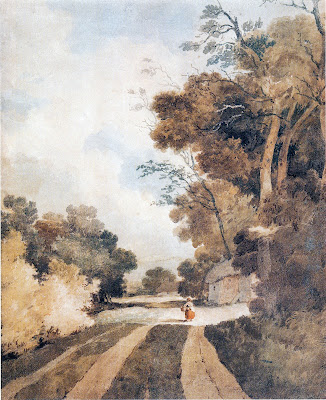 |
| Durer, The large piece of turf, 1503 |
Re-reading a classic book from many years ago is always a
challenging business. Scholarship has moved on, the world is a different place,
we are not the same people we were when we first read the book. Landscape
into Art was a book I greatly enjoyed when, aged around 20, I first read it.
It didn’t feel like a work of scholarship, but a personal, heart-felt response
to paintings the author loved – he was certainly unstinting with praise or
condemnation towards the artists he describes. Most importantly, he asked the
fundamental question: why landscape?
Perhaps it is not surprising that, rereading the book many years later, the impression I have is rather different. Today I find the book unbalanced, missing lots of key examples, and with the wrong emphasis.
The book originated as a series of lectures. Perhaps this format lends itself to bold assertions. Certainly, Clark puts his finger on it from the first page of the introduction: ““Landscape painting was the chief artistic creation of the nineteenth century”. More than that, he goes on to state “landscape painting has by now become the dominant art”.
So far, so good; but there are a lot of paintings discussed in the book which are not, in my opinion, landscapes. I understand “landscape painting” to be a new genre from the 19th-century, the representational depiction of the natural environment as a subject in its own right. Clark, rather oddly, only defines his terms in the epilogue to the book. By “nature”, he means “that part of the world not created by man, which we can see with our unaided senses”. In other words, the depiction of nature includes trees, water, sea, but not, primarily, buildings. I assume by “nature” Clark does not mean “people”, although the book describes many works that are primarily about people – more than half of the book discusses religious works, or paintings primarily about people.
Clark divides precursors of landscape art into four types, but the link between them and what I call the naturalistic tradition is perhaps greater than Clark imagines. These precursors, taking up four of the book’s seven chapters, are:
Ch 1 The landscape of symbols
(medieval art)
Ch 2 Landscape of Fact (Van Eyck,
Breughel, C17 Dutch landscape)
Ch 3 Landscape of Fantasy
(Grunewald, Altdorfer)
Ch 4 Ideal Landscape (Giorgione,
Claude, Poussin, Palmer)
One of these chapters, the Landscape of Fantasy, is by Clark’s definition not about nature. Much of the landscape of symbolism I find to be more about the symbol than about representation.
 |
| John White Abbott, View near Canonteign, Devon, 1803 |
All of this is simply leading up to what he calls “the naturalistic tradition” in chapter five. Here, Clark describes the naturalistic tradition as an achievement of the C19, but surely there were painters creating works like this well before, back in the C18, and earlier. I don’t mean ideal art, like Claude, or Richard Wilson, but painters on a smaller scale, and often in watercolour. There are, of course, many nature studies by Durer, from around 1500, but then there are many eighteenth-century landscape studies in the English watercolour tradition, such as Alexander Cozens (mentioned briefly here, but not illustrated), John Robert Cozens (died 1797), Paul Sandby (died 1809), Thomas Jones (died 1803), William Pars (died 1782), and many others. Even where Clark mentions major schools of landscape painters, he doesn’t seem to follow his own guidelines. Perhaps the real reason why Clark gave these painters so little appreciation is that for many years they were seen as somehow subsidiary to the great painters in oil (or tempera). The greatest artists were Michelangelo and Leonardo, and landscape hardly counted in the High Renaissance. Incidentally, all the illustrations for this post use pictures that were not mentioned by Clark.
As we read the book, we see some further criteria that Clark uses to value art. Meindert Hobbema is dismissed as “tedious” because “the elaborately described trees in his woodland scenes are not subordinated to a general principle of light (chapter 2)”. So light is the key, not trees or plants. More than that, the painting of light has to be “an act of love” rather than a trick (a term that dismisses all landscape painting from the end of the 17th-century until Constable or Turner). Moreover, landscape painting has to be sincere, not as in the works of Guardi, “the world of artifice” (unlike, strangely, Canaletto). The correct attitude to nature, in Clark’s view, is Wordsworthian … “the final stage in the development of man’s relations with nature” [p89]. Wordsworthian art is more than simply happiness. Clark on the Impressionists: “Impressionism was the painting of happiness … the impressionists were thereby cut off from the deepest intuitions of the human spirit” [p110]. Wordsworthian art is more a matter of love: ““van Eyck … Bellini … Claude … show us that the representation of light owes its aesthetic value to the fact that it is an expression of love.” [Epilogue]




No comments:
Post a Comment